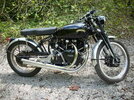Trevor, you might have been a few kms from shutdown. The Shorai site provides a discharge chart , along with a warning not to go below 12.86 volts. If you are somehow able to maintain a battery above 12.86 volts at all times while running a dead loss system, then it will be fine. Drop below this and get the double whammy, problems on the road and a very expensive junk battery.
I accomplished this very feat last June when coming home from Crawford Bay in South Eastern British Columbia. My Norton charging system failed and after an unknown number of miles , the bike died. The point at which the charging system failed is unkown because it has an idiot light and the idiot in charge of the light did not replace it some time ago when it burned out. So it could have been non functioning when I started the trip, about 1300 kms total. Anyway, the voltage dropped below the critical point for Boyer ignition about 500 kms from home on the return trip. No problem, I have a spare fully charged Li 20pb /eq Battery in the pannier. At this point I still thought 20 pb/eq was the same as a lead acid 20 ah, which is about small car battery size in Lead acid.In reality I had about 6 AH in the Battery, though it did not even seem to go as far as 6 AH ought to.
The Li Battery made it about 40 miles down the road and then it was ignition off time again. I checked the voltage and it wa hovering between 12.5 with no load and limp mode 5volts with lighting load, so fully discharged. Fortunately the Li battery ran out of steam at the top of a several miles long steep hill. I was able to coast right into the little town of Osooyos which sits at the bottom of the long hill. Actually I coasted into the Dairy Queen parking lot, which was ideal. I was able to sit in the airconditioned DQ (very hot day) and slurp ice cream while my friends went down the street to purchase a big lead acid battery for me. They came back with the propersized YTX 14 battery, OE size for the Norton. It ran the bike about 400 kms to home deadloss, andstill had lots of charge left. The Li battery apparently did not like being fully discharged to 12.5 volts, and that was the end of it, it no longer holds a charge.
Glen

